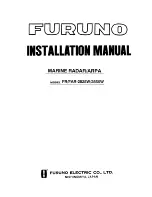
10-1
10. Route Planning
A route plan defines the navigation plan from starting point to the final destination. The plan includes:
•
Route name
•
Name, latitude and longitude of each waypoint
•
Radius of turn circle at each waypoint
•
Safe channel limits
•
Chart alarm calculation based on channel limits against chart database and user chart danger
•
Deadband width, nominal deadband width used for operating modes with moderate accuracy and economical
sailing behaviour
•
Minimum and maximum speed for each leg
•
The navigation method (rhumb line, great circle)
•
Fuel saving
•
ETD for the first waypoint
•
ETA for the last waypoint
•
Ship and environmental condition affecting the ship speed calculation
•
Name of the user chart to use during route monitoring together with this planned route
1. Name of the Notes to use during route monitoring together with this planned route
Using the above-mentioned data, the system calculates speed, course and length for each leg, ETAs for each
waypoint, fuel consumption and WOP. It also calculates safe water areas based on user-defined channel limits. The
calculated data is displayed in tabular form, which can be printed as a documented route plan and also stored in a
file for later use.
Main functions of route planning are:
•
Define waypoints
•
Define turnings for each waypoint
•
Define channel limits for each leg (a leg is the line connected between two waypoints). The channel limits are
used to detect chart alerts when you are planning or monitoring your route.
•
Define the speed for each leg
•
Calculation for ETD and ETA
•
Calculation for most economical sailing
Note: Limitation of displayed route
If you have small scale chart(s) on display having the whole eastern/western (0-180°E/0-180°W) hemisphere and a
part of the other hemisphere on display, there is a limitation to display a route. To avoid this, set chart center so that
the whole eastern/western hemisphere is not on display
Summary of Contents for FCR-2107 series
Page 42: ...1 Operational Overview 1 20 This page intentionally left blank...
Page 154: ...5 AIS Operation 5 28 This page intentionally left blank...
Page 255: ...7 Vector Chart Material 7 83 Recommended track defined by two beacons...
Page 256: ...7 Vector Chart Material 7 84 Recommended track defined by a building and a beacon...
Page 257: ...7 Vector Chart Material 7 85 Measurement mile tails tails...
Page 298: ...9 Chart Alerts 9 14 This page intentionally left blank...
Page 322: ...10 Route Planning 10 24 This page intentionally left blank...
Page 368: ...14 Backup Operations 14 6 This page intentionally left blank...
Page 404: ...16 Recording Functions 16 16 This page intentionally left blank...
Page 406: ...17 NAVTEX Messages 17 2 This page intentionally left blank...
Page 416: ...19 Parameters Setup 19 8 This page intentionally left blank...
Page 457: ...Appendix 2 IHO ECDIS Chart 1 AP 5 Nature and Man made features Port features...
Page 458: ...Appendix 2 IHO ECDIS Chart 1 AP 6 Depths Currents etc Seabed Obstructions Pipelines etc...
Page 459: ...Appendix 2 IHO ECDIS Chart 1 AP 7 Traffic routes Special areas...
Page 460: ...Appendix 2 IHO ECDIS Chart 1 AP 8 Aids and Services Buoys and Beacons...
Page 461: ...Appendix 2 IHO ECDIS Chart 1 AP 9 Topmarks Color test diagram...
Page 462: ...Appendix 2 IHO ECDIS Chart 1 AP 10 Mariners navigational symbols...
Page 469: ...Appendix 3 Interpreting S57 Charts AP 17 Fog signals Radars Services...
Page 476: ...Appendix 3 Interpreting S57 Charts AP 24 This page intentionally left blank...
Page 511: ...Appendix 5 Digital Interface AP 59 NRX NAVTEX received data...
Page 544: ...Appendix 6 Parts List and Parts Location AP 92 This page intentionally left blank...
Page 550: ...This page is intentionally left blank...
Page 556: ......
















































